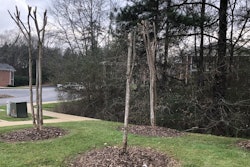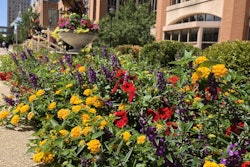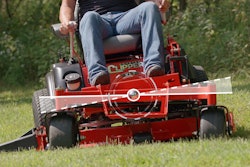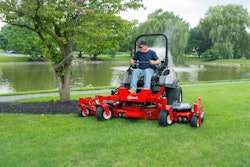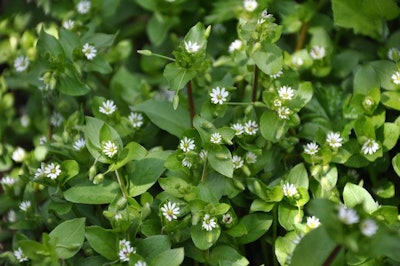 Photo: Wikipedia
Photo: WikipediaA widespread and successful weed thanks to its adaptability to a variety of environmental conditions, common chickweed is fairly competitive and can form dense patches that will crowd out customers’ turfgrass.
It can be found in lawns and landscape beds, particularly in shaded, moist areas. Common chickweed is known to be a reservoir for insect pests and plant viruses.
How to identify it
Common chickweed (Stellaria media) is a low-spreading winter annual or perennial with a shallow root system.
It forms prostate patches in lawns but may have more upright growth if not mowed. It has leaves that are egg-shaped and pointed at the tip and small flowers with five deeply divided petals that appear like 10 separate flower petals.
Common chickweed can look like mouse-ear chickweed (Cerastium vulgatum). The way to spot the difference is common chickweed leaves are light green and less hairy while the mouse-ear chickweed has dark green leaves that are covered in hair.
Sticky chickweed (Cerastium glomeratum) is an annual with more of an upright growth habit. Its leaves and stems are hairy and its glandular secretions give it a sticky feel. Sticky chickweed can also tolerate drier sites than common chickweed.
Field chickweed (Cerastium arvense) is a perennial with flower petals that are two to three times longer than the sepals and has shorter hairs on the stems and leaves.
It spreads its seeds that can germinate in early spring but typically occurs in the late summer or early fall. Flowering occurs in the early spring or late autumn. It can complete its lifecycle in five to six weeks.
Optimal germination temperatures for common chickweed are 53 to 68 degrees Fahrenheit.
How to control it
When chickweed appears, it’s commonly in weak lawns that are suffering from poor drainage or overwatering, but they also have a preference for nitrogen-rich soils. Shade and frequent watering encourage its growth.
Cultural control methods for common chickweed include hand pulling when small patches appear. This is only a viable option at the beginning of an infestation.
According to the UMass Extension Turf Program, it cannot tolerate hot, dry conditions and usually dies out by midsummer, so control may not be required.
Applying a layer of organic mulch in landscape beds can prevent the germination of chickweed seeds. Germination also decreases with the depth of the seed
Maintaining a lawn that is 3 to 3.5 inches tall can also help reduce the weed’s spread. It can survive under close mowing. Deep, infrequent irrigation also helps discourage chickweed infestations in lawns.
The University of California Integrated Pest Management Program advises opting for cultural control methods first, but if they cannot be used, herbicides can be an alternative.
For optimal control, apply preemergence herbicides before germination in late summer/early fall.
As for post-emergent chemicals, products with active ingredients such as fluroxypyr, triclopyr, florasulam or penoxsulam are effective. These should be applied to immature weeds in the fall.
If spring applications are made, more than one application may be necessary.
The turfgrass should not be mowed two to three days before and after the herbicide applications and it should be done at a time when no rainfall is expected for at least 12 hours.
